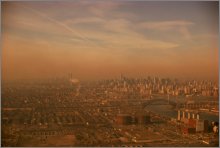|
|

|

Air Pollution: Check to See What Grade Your County Received, and the Cleanest & Dirtiest Air in America
by www.SixWise.com Overall, Americans are breathing easier than they did in
2005, but over 150 million of us are still exposed to unhealthy
levels of air pollution, according to the American Lung Association's
State of the Air 2006 report.
|

Want to live where the air is clean? See the
top 25 U.S. metropolitan areas with the cleanest
air year-round.
|
|
"Our report shows real improvement in the air
quality in much of the nation. We're seeing the benefits
of cleaning up dirty power plants with healthier air
and a better quality of life. But that doesn't mean
it's clean enough, and we've still got a lot of work
to do," said John L. Kirkwood, president and chief
executive officer of the American Lung Association.
As Kirkwood said, the Lung Association credits air
quality improvements to the federal efforts that have
been made to control pollution from power plants. However,
they are urging the Environmental Protection Agency
(EPA) to help reduce pollution from marine and locomotive
sources.
|
Who's at Risk From Air Pollution?
Air pollution can harm the health of just about anyone. It
is so serious that about 4 percent of deaths in the United
States can be attributed to air pollution, according to the
Environmental Science Engineering Program at the Harvard School
of Public Health. Further, it's estimated that those living
in the most polluted cities have their life spans shortened
by one to two years, according to research by the American
Cancer Society and Harvard University.
|

How's the Air You're Breathing?
Check out the American Lung Association's interactive
map to find out how your city's air ranked. Is it in
the 25 best or worst, or somewhere in between?
Find
Out if You're Breathing Polluted Air Now!
|
What types of health effects can be expected? Everything
from eye, throat and lung irritation to lung cancer and chronic
respiratory diseases. Other health effects of air pollution
include:
- Cough
- Chest tightness
- Difficulty breathing
- Headaches
- Nausea
- Asthma attacks
- Increased upper respiratory infections such as bronchitis
and pneumonia
- Heart disease
- Respiratory problems
- Exacerbated allergies
- Adverse neurological, reproductive and developmental effects
- Genetic abnormalities in newborns
The American Lung Association also pointed out that certain
groups are especially at risk from polluted air. These include:
- People with asthma
- Adults over 65
- Children under 18
- People with chronic obstructive pulmonary disease (COPD,
or chronic bronchitis and emphysema)
- People with heart disease
- People with diabetes
The 25 Metropolitan Areas With the Dirtiest Air
The State of the Air report ranks cities and counties according
to how much particle pollution (soot) and ozone (smog) they
contain. Said the Lung Association, these two pollutants still
represent "persistent threats against large parts of
the United States."
Along with the rankings, each county also receives a report
card based on their high ozone days and 24-hour particle pollution.
Chicago's
Cook County, IL, for example, earned an "F."
You can find out your county's grade using the American Lung
Association's interactive
map.
Here are the 25 metropolitan areas that ranked the worst
(areas with the same number were tied) in year-round particle
pollution.
- Los Angeles-Long Beach-Riverside, Calif.
- Bakersfield, Calif.
- Pittsburgh-New Castle, Pa.
- Visalia-Porterville, Calif.
- Fresno-Madera, Calif.
- Detroit-Warren-Flint, Mich.
- Hanford-Corcoran, Calif.
- Cleveland-Akron-Elyria, Ohio
- Birmingham-Hoover-Cullman, Ala.
- Atlanta-Sandy Springs-Gainesville, Ga.-Ala.
- Chicago-Naperville-Michigan City, Ill.-Ind.-Wis.
- Weirton-Steubenville, W.Va.-Ohio
- York-Hanover-Gettysburg, Pa.
- St. Louis-St. Charles-Farmington, Mo.-Ill.
- Cincinnati-Middletown-Wilmington, Ohio-Ky.-Ind.
- New York-Newark-Bridgeport, N.Y.-N.J.-Conn.-Pa.
- Lancaster, Pa.
- Merced, Calif.
- Canton-Massillon, Ohio
- Charleston, W.Va.
- Washington-Baltimore-Northern Virginia, D.C.-Md.-Va.-W.Va.
- Reading, Pa.
- Hagerstown-Martinsburg, Md.-W.Va.
- Indianapolis-Anderson-Columbus, Ind.
- Louisville-Elizabethtown-Scottsburg, Ky.-Ind.
Want to Breathe Easy? You May Want to Live Here
These 25 areas have the least amount of year-round particle
pollution in the country.
- Cheyenne, Wyo.
- Santa Fe-Espanola, N.M.
- Honolulu
- Great Falls, Mont.
- Tucson, Ariz.
- Anchorage, Alaska
- Farmington, N.M.
- Bismark, N.D.
- Albuquerque, N.M.
- Rapid City, S.D.
- Pueblo, Colo.
- Fort Collins-Loveland, Colo.
- Fargo-Wahpeton, N.D.-Minn.
- Duluth, Minn.-Wis.
- Salinas, Calif.
- Midland-Odessa, Texas
- Palm Bay-Melbourne-Titusville, Fla.
- Colorado Springs, Colo.
- Cape Coral-Fort Myers, Fla.
- Albany-Corvallis-Lebanon, Ore.
- Reno-Sparks, Nev.
- Redding, Calif.
- Port St. Lucie-Fort Pierce, Fla.
- Santa Barbara-Santa Maria-Goleta, Calif.
- San Luis Obispo-Paso Robles, Calif.
Protect Yourself and Your Family From Air Pollution
While the only way to avoid air pollution entirely is to
move to a pristine location, the following tips will help
to reduce the amount of pollution you're exposed to, no matter
where you live.
-
Keep Dirt and Dust Out of Your Home. A few high-quality
mats, like the Waterhog
Grand Premier Mats, placed strategically around your
home (such as in doorways and other highly trafficked
areas), will go a long way toward reducing the amount
of dirt and dust in your home in the first place. Once
inside, that dirt gets circulated into the air and you
breathe it in.
-
Avoid high levels of smog and pollution. These
are typically highest during the midday and afternoon.
If you're in a high-risk group, don't go outside when
ozone levels are high.
- Exercise when the air is cleaner. When we exercise
(or work strenuously), we draw air more deeply into our
lungs, and therefore risk more damage from air pollution.
To protect yourself and get the numerous
health benefits of exercise, avoid exercising near congested
streets and during rush-hour traffic, and try to work out
early in the morning or evening instead.
Recommended Reading
26
Simple & Smart Steps to Prevent Allergy Flare-Ups
How
to (and How NOT to) Sneeze and Blow Your Nose
Sources
American
Lung Association: State of the Air 2006
WebMD
April 27, 2006
To get more information about this and other highly important topics, sign up for your free subscription to our weekly SixWise.com "Be Safe, Live Long & Prosper" e-newsletter.
With every issue of the free SixWise.com newsletter, you’ll get access to the insights, products, services, and more that can truly improve your well-being, peace of mind, and therefore your life!
|
|
|
|